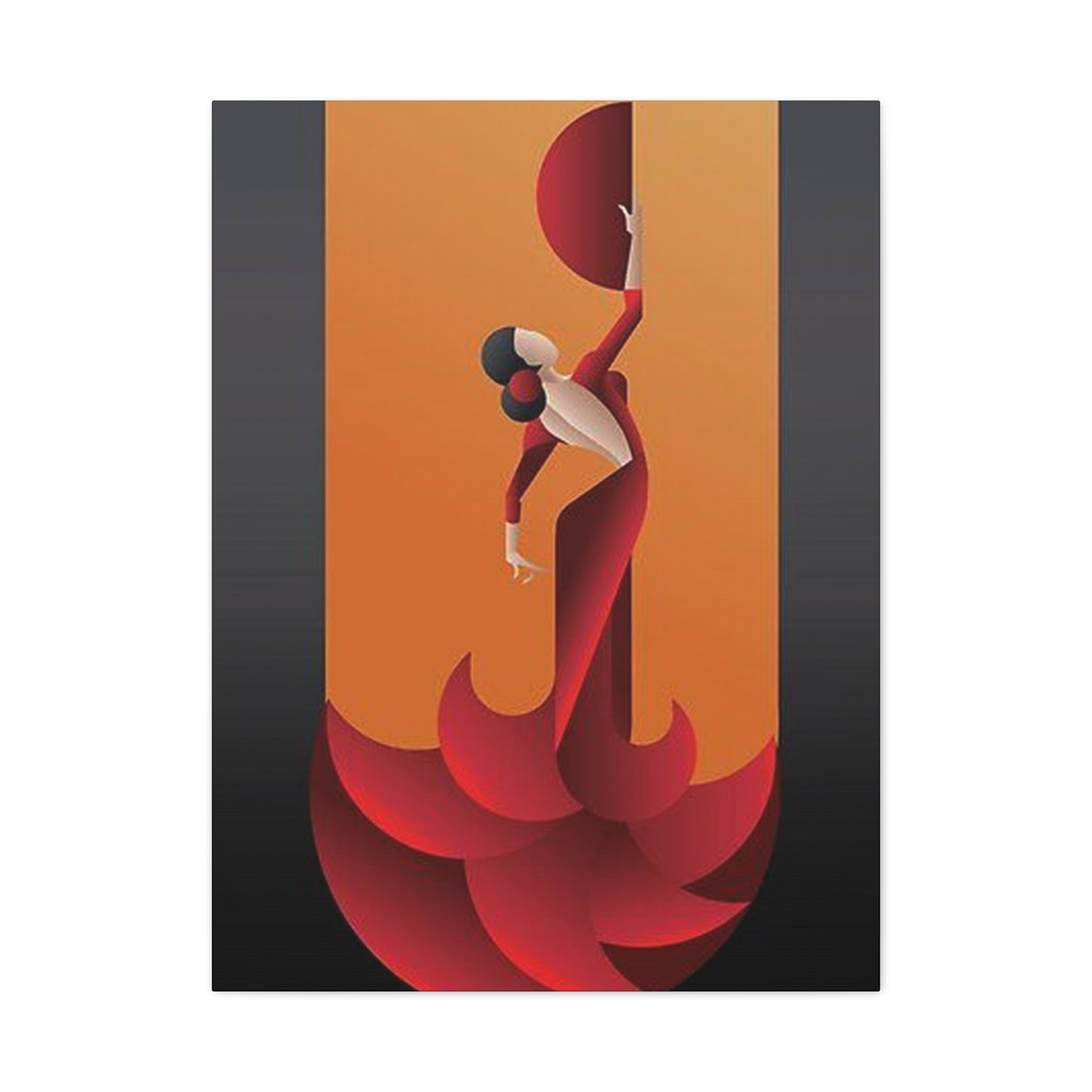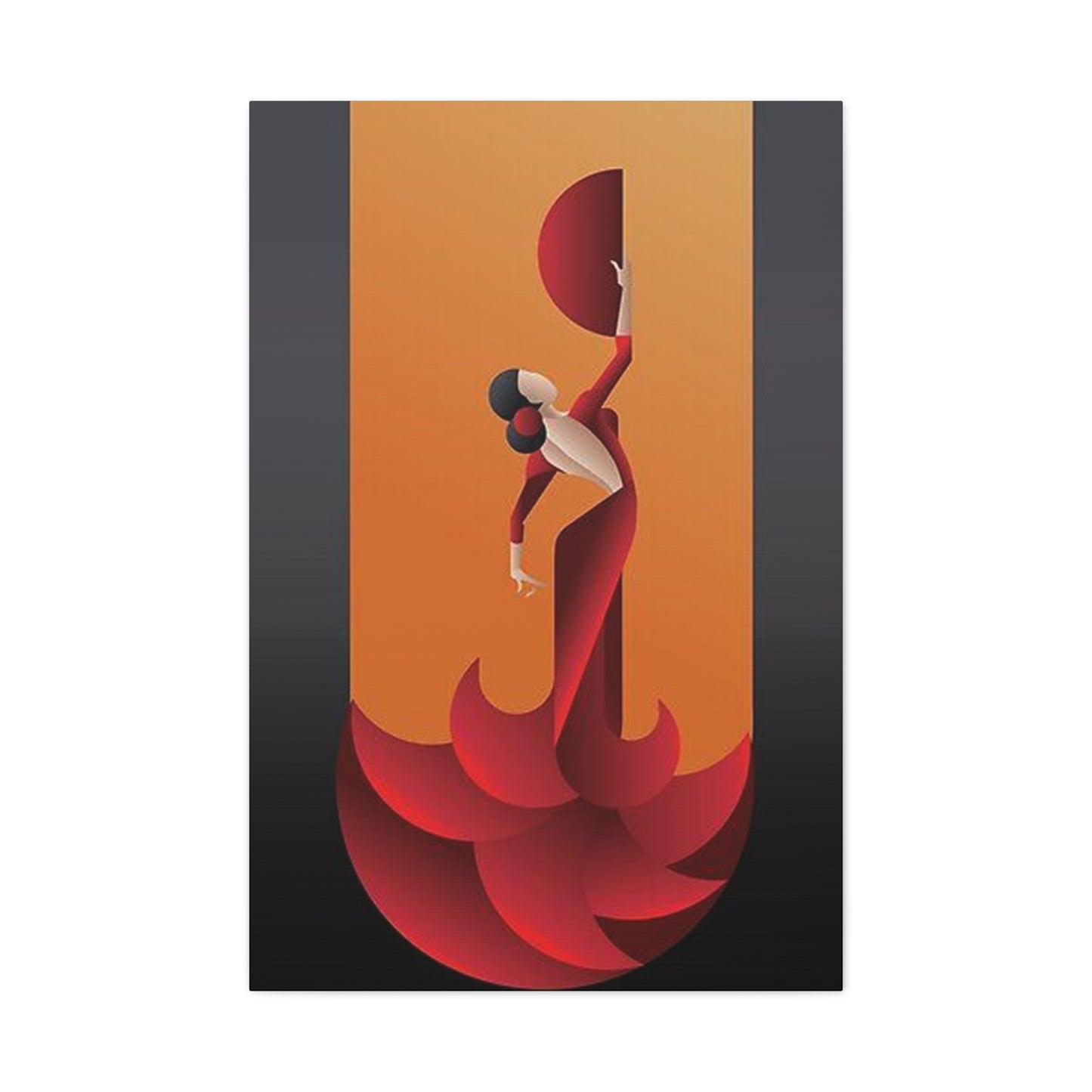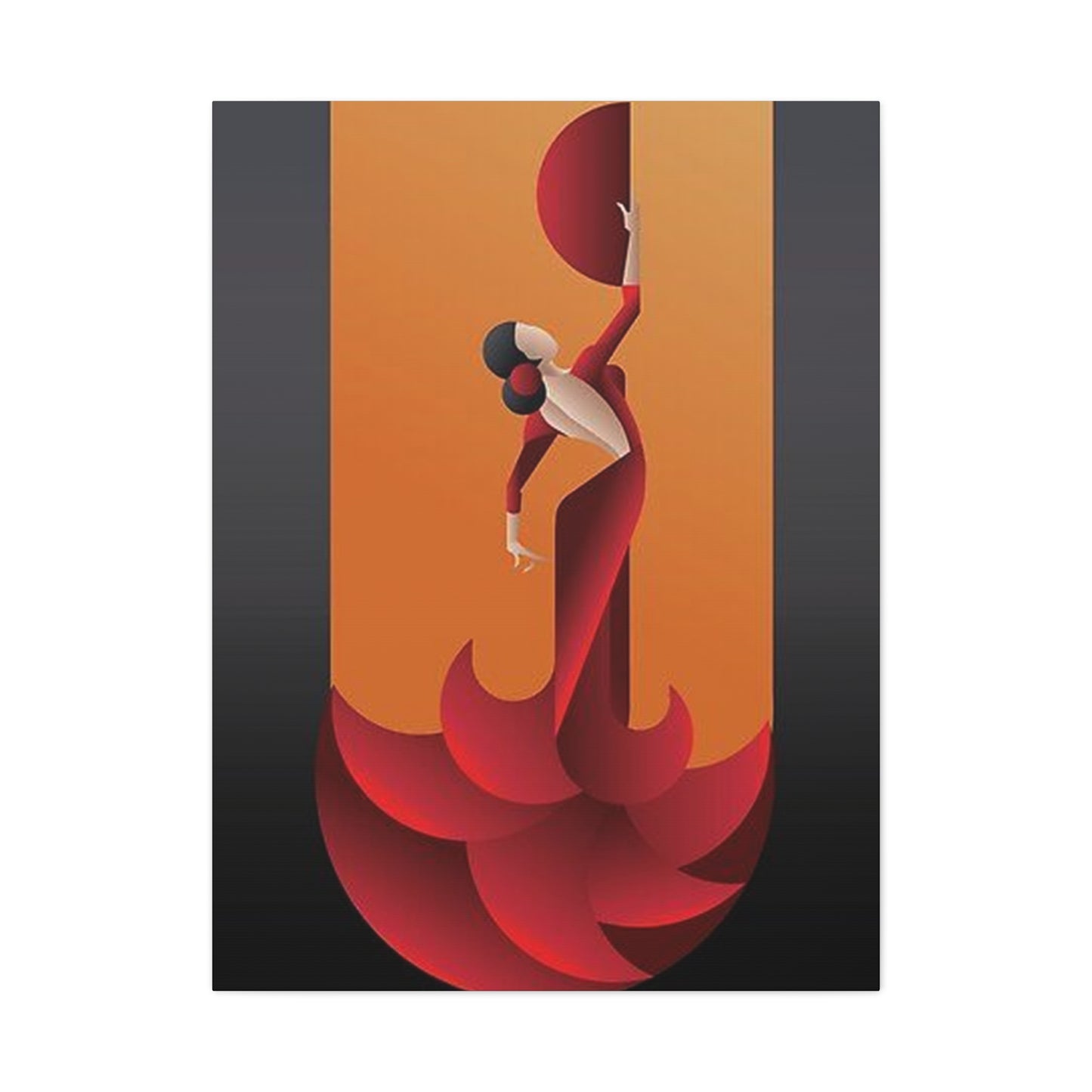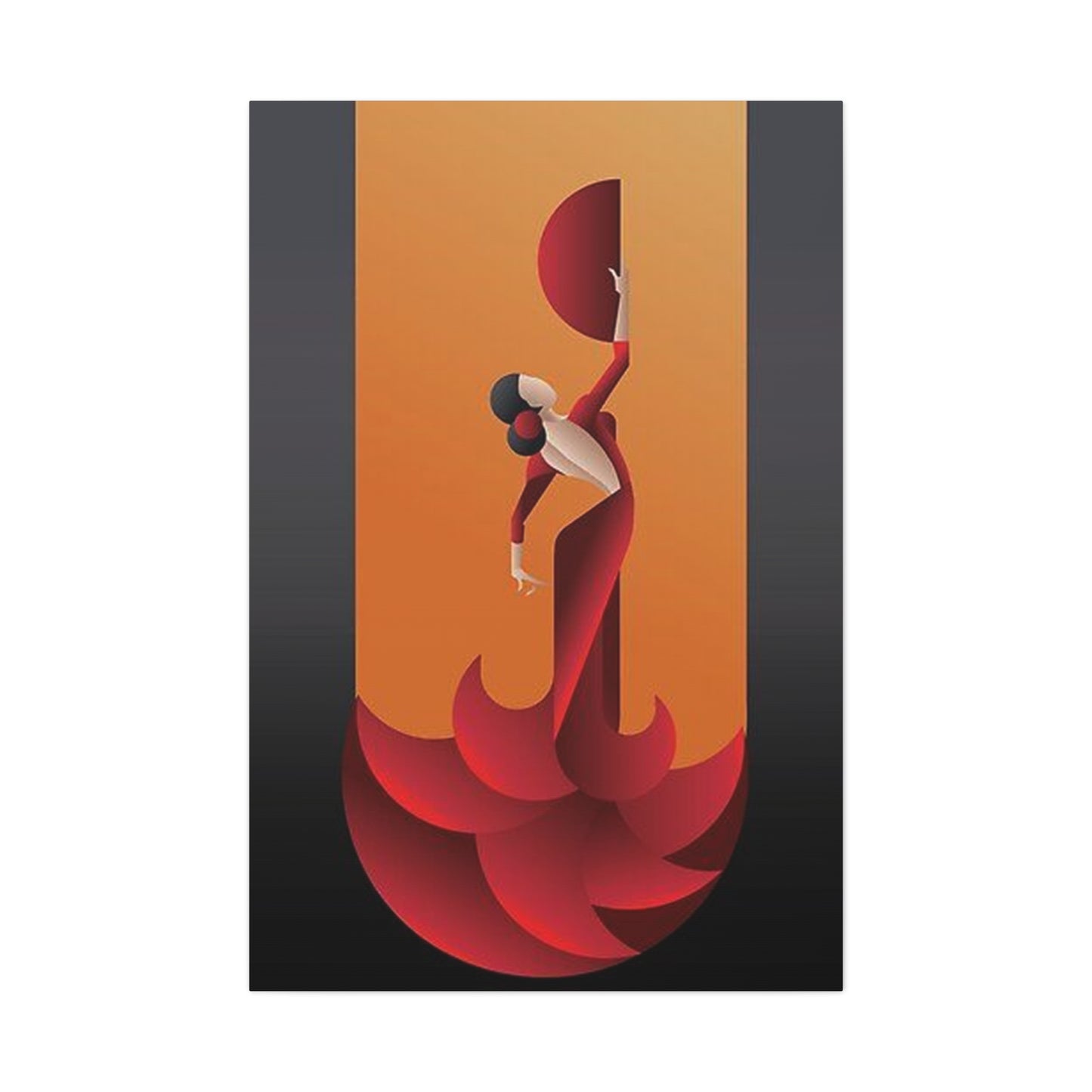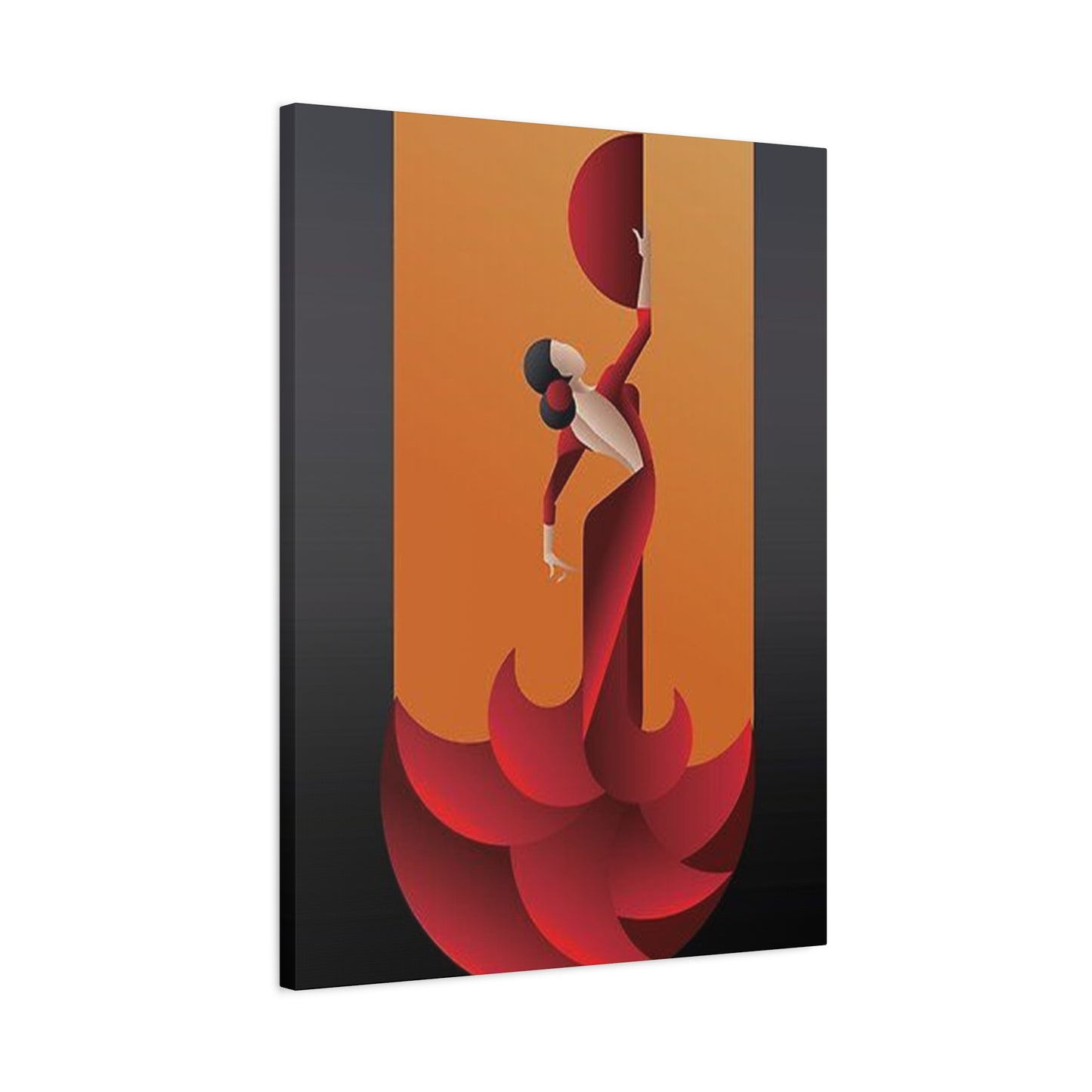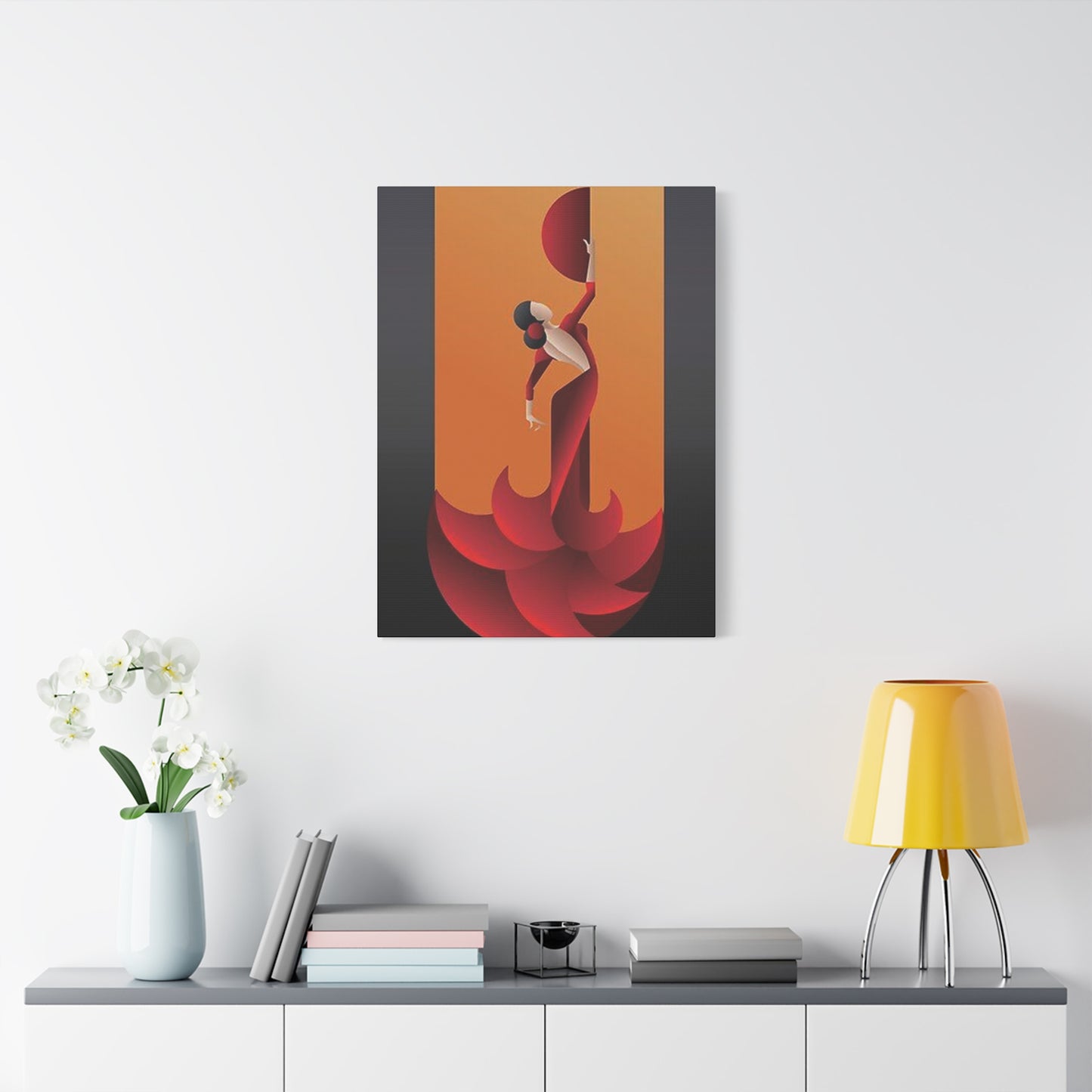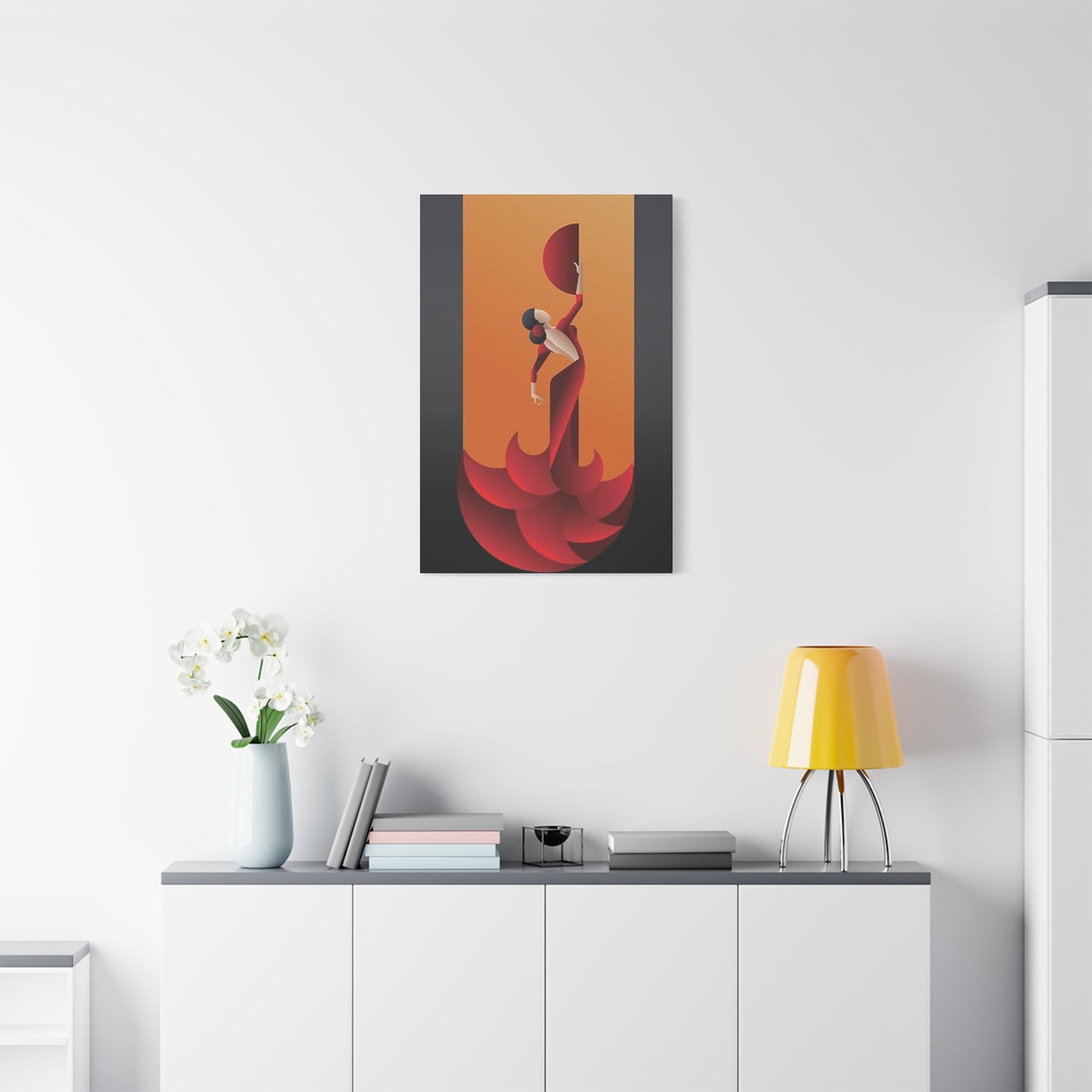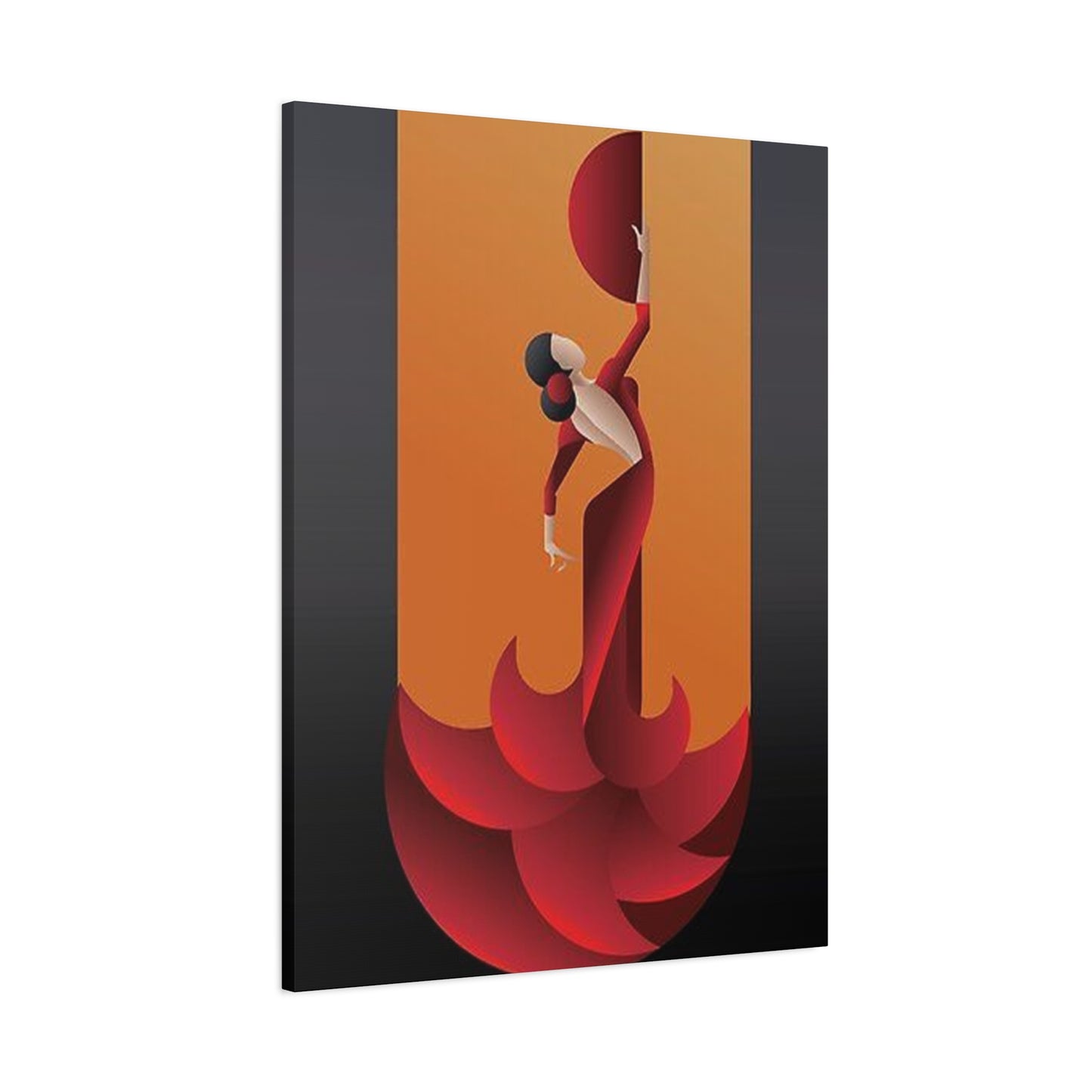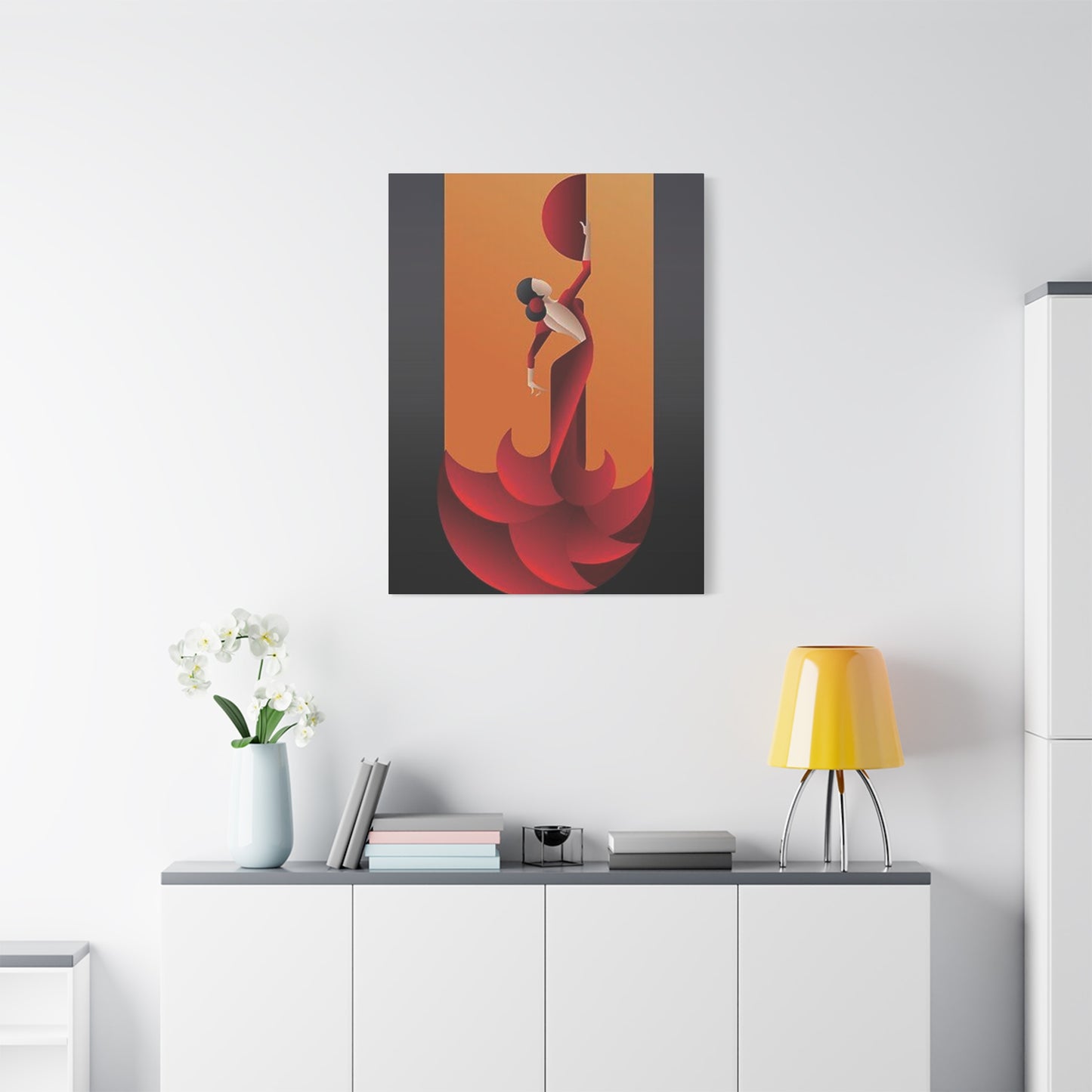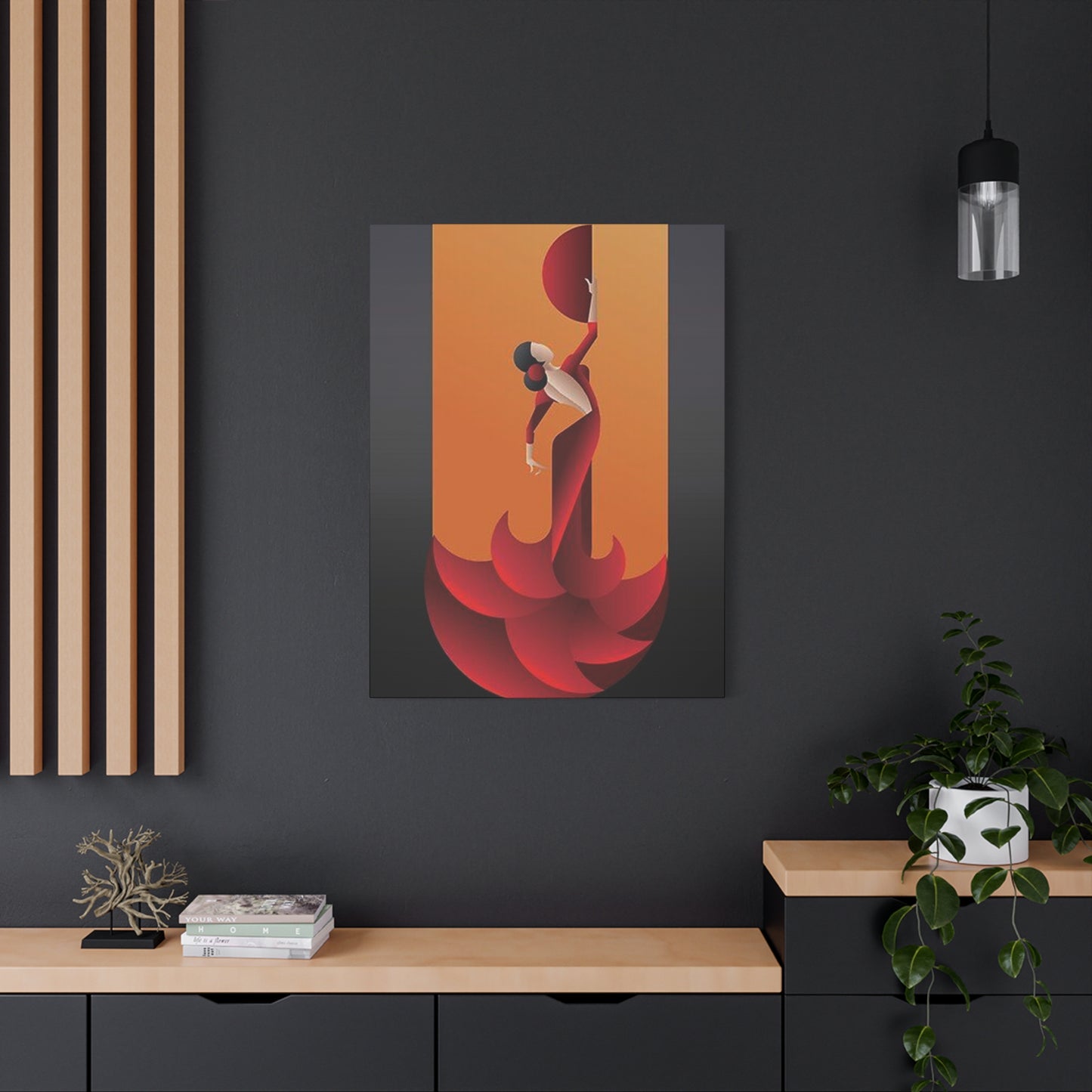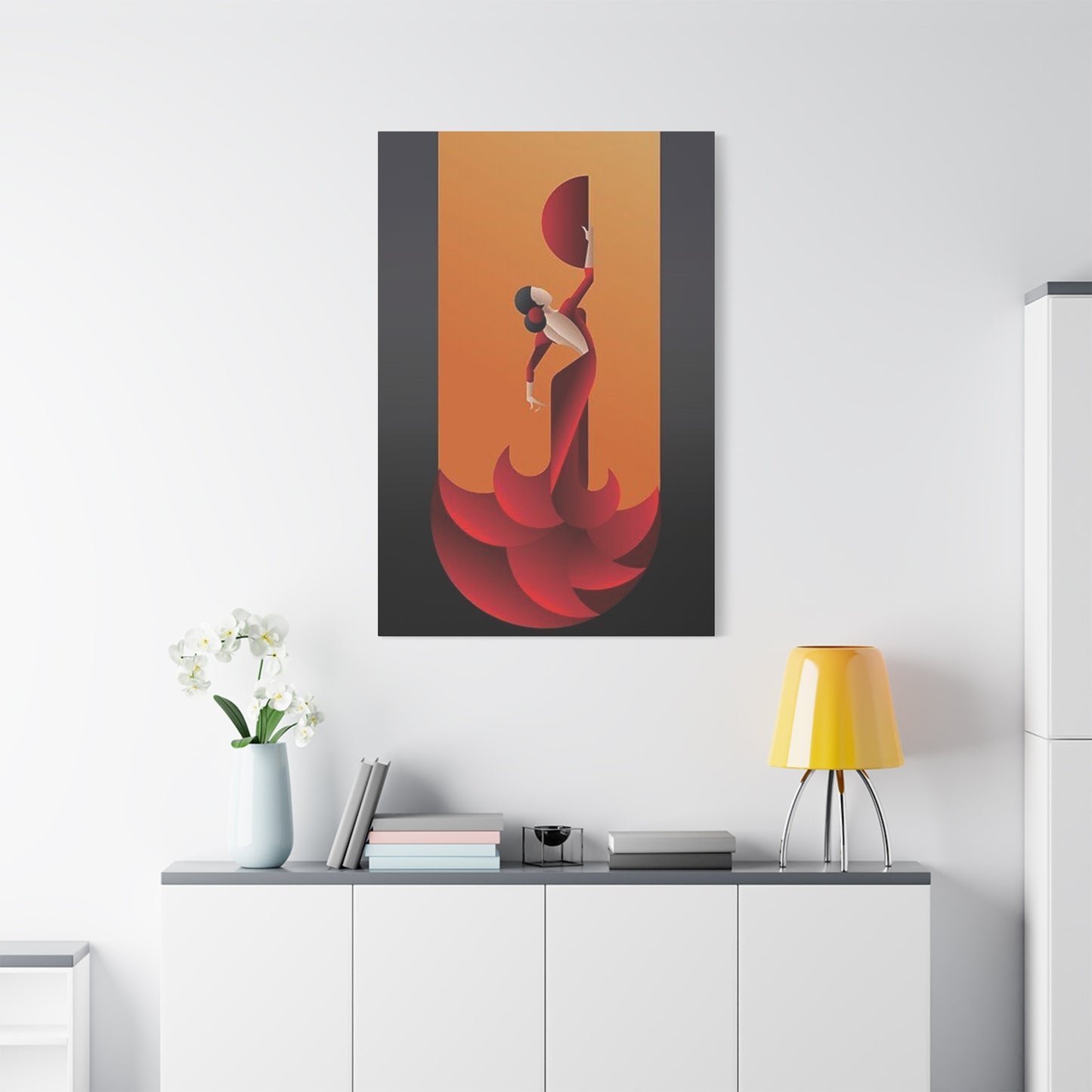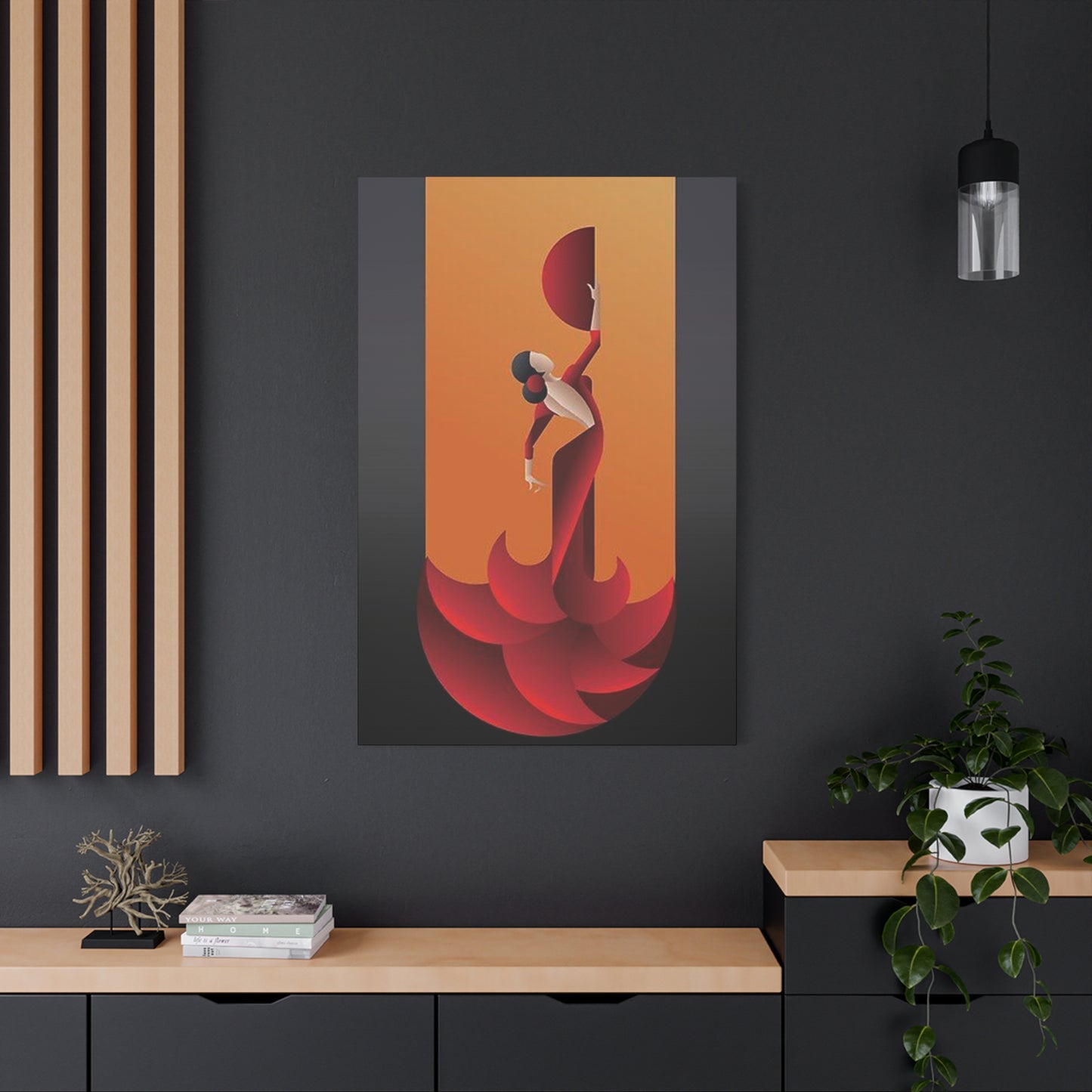A Definitive Exploration of Spanish Abstract Dance Wall Art: Visual Poetry in Motion
The world of Spanish abstract dance poster wall art represents a captivating fusion of cultural heritage, artistic innovation, and contemporary design sensibilities. This remarkable art form captures the essence of flamenco passion, the rhythm of traditional Spanish dance, and the bold expressiveness of abstract visual storytelling. When we explore this fascinating intersection of dance and visual art, we discover a rich tapestry of color, movement, and emotion that transforms ordinary living spaces into galleries of cultural celebration.
Spanish dance has always been characterized by its intense emotional expression, dramatic gestures, and the powerful connection between performer and audience. When artists translate these dynamic movements into abstract poster designs, they create visual poetry that speaks to the soul. The resulting wall art pieces become more than mere decorations; they serve as windows into a world where motion freezes in time, where passion crystallizes into form, and where the spirit of Spanish culture dances eternally across canvas and paper.
The popularity of abstract dance posters has surged in recent years as homeowners, interior designers, and art enthusiasts seek meaningful ways to personalize their spaces. These artworks offer a sophisticated alternative to conventional wall decorations, bringing an element of cultural refinement and artistic depth to any environment. Whether displayed in living rooms, dance studios, offices, or galleries, Spanish abstract dance posters command attention and spark conversation, inviting viewers to interpret the swirling forms and vibrant colors through their own emotional lens.
Historical Evolution of Spanish Dance in Visual Arts
Spanish dance has captivated artists for centuries, inspiring countless paintings, sculptures, and graphic works that attempt to capture the essence of this powerful performance tradition. From the classical paintings of Francisco Goya depicting Spanish dancers in traditional costume to the modernist interpretations of Pablo Picasso exploring the geometric forms of flamenco movements, visual artists have long been drawn to the challenge of translating kinetic energy into static imagery.
The transition from representational to abstract interpretations of dance began in earnest during the early twentieth century when avant-garde movements challenged traditional artistic conventions. Artists began experimenting with ways to convey movement, emotion, and rhythm without relying on literal depictions of human figures. This shift opened new possibilities for expressing the intangible qualities of dance through color relationships, gestural mark-making, and compositional dynamism.
Spanish dance particularly lends itself to abstract interpretation because of its inherently expressive nature. The sharp angles of a flamenco dancer's arms, the circular swirl of a traditional skirt, the staccato rhythm of heel strikes against wooden floors—all these elements possess inherent geometric and rhythmic qualities that translate beautifully into abstract visual language. Artists working in this tradition draw upon these fundamental shapes and patterns, reimagining them through a contemporary lens that emphasizes emotional impact over literal representation.
The development of poster art as a legitimate artistic medium has further democratized access to these visual interpretations of Spanish dance. Where original paintings might hang only in museums or private collections, poster reproductions allow anyone to bring sophisticated artistic vision into their personal spaces. Modern printing technologies have elevated poster quality to museum standards, with archival inks and premium papers ensuring that these reproductions maintain their vibrancy and impact for generations.
Color Psychology in Spanish Dance Poster Design
Color plays a pivotal role in abstract Spanish dance poster art, conveying the emotional intensity and cultural richness of the dance traditions they represent. The bold reds that dominate many pieces evoke the passion and fire associated with flamenco performance, channeling the emotional intensity that dancers bring to every movement. These crimson tones pulse with energy, suggesting the heat of Andalusian summers and the burning emotions expressed through dance.
Deep blacks provide dramatic contrast and grounding in many compositions, reflecting the traditional black costumes worn by flamenco performers and adding weight and sophistication to the overall design. These dark elements create visual anchors that allow brighter colors to pop and shine, establishing a rhythm of light and shadow that mirrors the dramatic contrasts found in Spanish dance music and movement.
Warm ochres and golden yellows frequently appear in abstract dance posters, referencing the sun-baked landscapes of Spain and bringing warmth to any space they inhabit. These earthy tones connect the artwork to the physical environment that gave birth to Spanish dance traditions, grounding the abstract forms in a sense of place and cultural authenticity. The golds particularly evoke the ornate decorations found on traditional dance costumes and the warm lighting of intimate tablao performances.
Cool blues and greens occasionally punctuate these warmer palettes, providing moments of visual relief and suggesting the emotional complexity within Spanish dance. These cooler hues might represent moments of melancholy or introspection within a performance, the brief pauses between passionate outbursts, or simply serve as compositional counterpoints that prevent the overall design from becoming visually overwhelming.
White spaces and lighter tones function as breathing room within these compositions, allowing the eye to rest and creating rhythm through the interplay of color and absence. These negative spaces are never truly empty but serve as active participants in the visual dance, their presence as important as the bold strokes of color they surround. Understanding this sophisticated use of color helps viewers appreciate the thoughtfulness behind seemingly spontaneous abstract designs.
Compositional Elements That Capture Dance Movement
Abstract artists employ various compositional strategies to convey the dynamic nature of Spanish dance within the static medium of poster art. Diagonal lines slash across many compositions, suggesting the dramatic angles created by dancers' bodies as they lean, turn, and gesture. These diagonal elements create visual tension and movement, pulling the viewer's eye across the composition in ways that mimic the sweeping motions of dance performance.
Circular forms frequently appear in abstract dance posters, referencing the spinning movements central to many Spanish dance forms. These curves might represent the circular motion of arms in classical Spanish dance, the rotation of dancers during turns, or the flowing circles created by swirling skirts. The repetition of circular elements throughout a composition creates rhythm and unity, establishing visual patterns that echo the musical patterns underlying dance performance.
Layering techniques add depth and complexity to abstract dance posters, with multiple translucent forms overlapping to create rich visual textures. This approach mirrors the layered complexity of actual dance performance, where music, movement, costume, and emotion all combine to create a unified artistic experience. The transparency effects possible in modern poster design allow artists to suggest multiple dancers, multiple moments in time, or multiple interpretations existing simultaneously within a single frame.
Gestural brushstrokes or their digital equivalents inject spontaneity and energy into many abstract dance designs. These marks carry the immediacy of movement, suggesting the physical act of dancing through the physical act of mark-making. Whether created with actual paint or simulated digitally, these gestural elements communicate the bodily nature of dance, reminding viewers that both dance and visual art originate in physical human action.
Balance and asymmetry work together in sophisticated abstract dance compositions, creating visual interest while maintaining overall harmony. A large bold form on one side of the composition might be balanced by several smaller elements on the other, creating dynamic equilibrium that mirrors the physical balance required in dance. This careful attention to compositional structure ensures that even the most energetic abstract designs maintain visual coherence and remain pleasant to view over extended periods.
Cultural Symbolism Embedded in Abstract Dance Imagery
Spanish abstract dance poster art carries layers of cultural meaning that extend beyond pure aesthetic considerations. The visual vocabulary employed by artists working in this tradition draws deeply from Spanish cultural symbols, even when rendered in abstract forms. The fan motif appears frequently, sometimes clearly recognizable and other times suggested through curved lines and radiating patterns. This iconic accessory of Spanish dance carries associations with femininity, mystery, and the controlled revelation that characterizes flamenco performance.
Floral elements, particularly roses, make abstract appearances in many designs, referencing the traditional practice of dancers wearing flowers in their hair or holding them during performances. These botanical references might be highly stylized or reduced to essential curved forms, but they carry cultural resonance for viewers familiar with Spanish dance traditions. The flower symbolism connects the art to themes of beauty, passion, and the natural world.
Polka dot patterns, characteristic of traditional flamenco dresses, sometimes appear in abstract configurations throughout poster designs. These repetitive elements create visual rhythm while nodding to specific costume traditions. The dots might be rendered in regular patterns or scattered irregularly across the composition, but their presence immediately evokes the visual style of flamenco fashion.
Guitar silhouettes or abstract references to musical instruments appear in some designs, acknowledging the inseparable relationship between Spanish dance and music. Even when highly abstracted, these instrumental references ground the artwork in the sonic dimension of dance performance, reminding viewers that movement and music form an integrated artistic whole. The curved body of a guitar lends itself naturally to abstract interpretation, its organic form harmonizing with the flowing lines used to suggest human movement.
Architectural elements referencing Spanish design occasionally appear in abstract dance posters, with arched forms suggesting Moorish influences or geometric patterns evoking Andalusian tilework. These environmental references situate the dance within its cultural context, connecting the artwork to the physical spaces where Spanish dance traditions developed and continue to thrive. The architectural elements provide stability and structure within compositions that might otherwise feel entirely fluid and ungrounded.
Materials and Printing Techniques for Museum-Quality Results
The physical production of Spanish abstract dance posters involves careful consideration of materials and techniques to ensure the final product does justice to the artistic vision. Premium paper stocks provide the foundation for high-quality poster reproductions, with options ranging from smooth fine art papers to textured watercolor papers that add tactile dimension to printed designs. The choice of paper significantly affects how colors appear and how light interacts with the finished piece.
Archival pigment inks have revolutionized poster printing, offering color accuracy and longevity that rival traditional art mediums. These specialized inks resist fading when exposed to light, ensuring that the vibrant colors characteristic of Spanish dance posters remain true for decades. The permanence of archival inks makes contemporary posters legitimate art investments rather than temporary decorations, justifying the care and thought that goes into selecting and displaying them.
Giclée printing technology represents the gold standard for art reproduction, using sophisticated inkjet systems to apply microscopic ink droplets with extraordinary precision. This technique captures subtle color gradations and fine details that earlier printing methods could not reproduce, allowing abstract dance posters to maintain the nuanced color relationships and textural qualities present in original artworks. The term giclée itself has become synonymous with quality in the art print market.
Some artists and producers offer hand-finished posters that incorporate actual painted elements or embellishments applied after the initial printing process. These unique touches transform each poster into an original artwork rather than a pure reproduction, adding value and individuality. Hand-applied gold leaf, textured varnishes, or painted accents can elevate a poster from wall decoration to genuine art object.
The sizing and formatting of abstract dance posters requires thoughtful consideration to ensure the artwork displays effectively in various spaces. Standard poster sizes offer practical advantages in terms of framing options and shipping, but custom sizing allows collectors to commission pieces perfectly proportioned for specific walls or display contexts. Vertical orientations often suit dance-themed artwork particularly well, as they echo the vertical emphasis of standing human figures, even when those figures are rendered abstractly.
Interior Design Applications and Styling Approaches
Spanish abstract dance poster art integrates beautifully into diverse interior design schemes, offering flexibility that makes these pieces suitable for various aesthetic approaches. In contemporary minimalist spaces, a single bold abstract dance poster can serve as a focal point, providing visual interest and emotional warmth without cluttering the clean lines characteristic of minimalist design. The strong graphic quality of abstract work complements minimalist principles while injecting personality and cultural depth.
Maximalist interiors benefit from the layering possibilities that abstract dance posters provide, with multiple pieces arranged in gallery wall configurations that create visual impact through abundance and variety. The bold colors and dynamic compositions characteristic of this art form hold their own among pattern-rich textiles, collected objects, and the visual complexity that defines maximalist spaces. The cultural specificity of Spanish dance imagery adds to the layered narrative that maximalist design often seeks to create.
Traditional interiors find surprising harmony with abstract Spanish dance posters when styling emphasizes the cultural and historical dimensions of both the space and the artwork. The warmth and richness of traditional Spanish colors complement classic furnishings in wood and leather, while the abstract nature of the art prevents any sense of dated literalism. This combination creates spaces that feel rooted in tradition while remaining thoroughly contemporary.
Bohemian and eclectic interiors naturally embrace abstract dance posters, as these design approaches celebrate artistic expression and cultural appreciation. The colorful, expressive nature of Spanish dance art aligns perfectly with bohemian values, while the specific cultural tradition it represents adds authenticity to spaces that might otherwise risk feeling generic or appropriative. Layering dance posters with textiles, plants, and global artifacts creates rich, personality-filled environments.
Professional spaces including offices, studios, and commercial environments benefit from the sophisticated energy that abstract dance posters bring. These artworks project creativity, passion, and cultural awareness—qualities many businesses wish to associate with their brand identity. In creative industries particularly, Spanish abstract dance art signals artistic credibility and appreciation for cultural expression, creating environments that inspire both employees and clients.
Selecting the Right Abstract Dance Poster for Your Space
Choosing an abstract Spanish dance poster requires consideration of multiple factors to ensure the piece enhances rather than overwhelms or gets lost within your space. Scale represents perhaps the most critical consideration, as artwork must be appropriately sized for the wall it will occupy. A piece too small appears insignificant and fails to make intended impact, while an oversized poster can dominate a space uncomfortably. Measuring your wall space carefully and considering the proportions of surrounding furniture helps determine ideal dimensions.
Color coordination between the poster and existing room colors creates visual harmony and ensures the artwork feels integrated rather than jarring. This doesn't mean the poster must exactly match your color scheme—in fact, introducing complementary or contrasting colors often creates more interesting results. Consider pulling accent colors from the poster into other design elements through throw pillows, rugs, or accessories to create visual connections throughout the space.
The specific style of abstraction matters when selecting a poster, as abstract art exists on a spectrum from barely abstracted representations to completely non-objective compositions. More representational abstract pieces showing recognizable dancer silhouettes or clear references to Spanish dance might work better in spaces where you want the artwork's subject matter immediately apparent. Highly abstract pieces that reduce dance to pure color and form suit spaces where you want artwork that invites contemplation and personal interpretation.
The emotional tone conveyed by different abstract dance posters varies considerably, from explosive energetic compositions to more subtle, contemplative designs. Consider the mood you want to create in the space where the poster will hang. Bedrooms might benefit from pieces with calmer energy, while living areas or studios might accommodate more dynamic, stimulating designs. The artwork should support the intended function and feeling of the space rather than working against it.
Artist reputation and production quality deserve attention when investing in poster art, particularly for pieces that will be prominently displayed. Research the artist's background and aesthetic vision to ensure their work resonates with your personal taste. Investigate the printing method, paper quality, and ink type to confirm you're purchasing a piece that will maintain its beauty over time. Museum-quality reproductions justify higher prices through superior materials and production standards.
Framing and Display Techniques for Maximum Impact
Proper framing dramatically enhances the presentation of abstract Spanish dance posters, protecting the artwork while elevating its visual impact. Frame selection should complement rather than compete with the poster, supporting the artwork without overwhelming it. Simple black frames offer timeless elegance that suits most abstract dance designs, allowing the bold colors and dynamic compositions to remain the focus. Natural wood frames can warm the presentation and emphasize the organic, human dimensions of dance expression.
Matting provides breathing room between the artwork and frame, creating visual separation that allows the composition to be fully appreciated. White or cream mats offer classic, gallery-style presentation, while colored mats can pick up accent colors from the poster itself, creating cohesive presentation. The width of the mat border affects the overall look, with wider borders creating more formal presentation and narrower borders feeling more contemporary and intimate.
Glass or acrylic glazing protects poster surfaces from dust, moisture, and handling while allowing clear viewing. Standard glass works well for most applications, while museum-quality UV-protective glass offers superior protection against light damage for valuable or significant pieces. Acrylic glazing provides shatter-resistance and lighter weight, making it ideal for larger posters or spaces where safety concerns exist. Anti-reflective coatings on either glass or acrylic ensure the artwork remains clearly visible from various angles without distracting glare.
Mounting techniques affect how the poster sits within the frame and influences its long-term preservation. Acid-free mounting boards and archival tapes prevent chemical damage that could yellow or deteriorate the paper over time. Floating mounts create shadow gaps between the poster and mat, adding dimensional interest and emphasizing the paper edges. Professional framers can recommend mounting approaches appropriate to the poster's value and your preservation priorities.
Hanging height significantly impacts how effectively a poster commands attention and integrates into the space. The general guideline of centering artwork at eye level works well for most situations, though this standard should be adjusted based on ceiling height, furniture placement, and viewing angles. In dining areas, artwork might hang slightly lower to be viewed comfortably while seated. Above furniture, posters should hang with appropriate clearance—typically six to twelve inches above sofas or console tables.
The Intersection of Traditional Dance Forms and Modern Abstraction
Spanish dance encompasses multiple distinct traditional forms, each with characteristic movements, costumes, and cultural contexts that inform abstract visual interpretations. Flamenco stands as perhaps the most internationally recognized Spanish dance form, characterized by its intense emotional expression, percussive footwork, and intricate hand movements. Abstract artists drawing from flamenco traditions emphasize angular shapes, staccato rhythms, and fiery color palettes that capture the passionate intensity of this Andalusian art form.
Classical Spanish dance represents a more refined, ballet-influenced tradition that blends Spanish folk elements with formal technique. The elegant arm positions, graceful turns, and theatrical presentation of classical Spanish dance inspire abstract compositions that emphasize flowing lines, circular forms, and sophisticated color harmonies. The formal structure of classical dance translates well into carefully composed abstract designs that balance spontaneity with deliberate compositional choices.
Regional folk dances from throughout Spain offer rich visual vocabularies for abstract interpretation, with each region's traditional dances featuring distinctive costumes, movements, and cultural meanings. The Sardana from Catalonia, the Jota from Aragon, the Muñeira from Galicia—each brings unique characteristics that artists can explore through abstract means. These regional traditions ensure that Spanish dance poster art can reference specific cultural identities rather than presenting a monolithic vision of Spanish culture.
Sevillanas, the popular social dance associated with festivals and celebrations, contributes lighter, more festive energy to abstract dance art. The partnered nature of Sevillanas and its association with communal celebration inspires compositions that suggest interaction, joy, and social connection. Abstract interpretations of Sevillanas might feature multiple forms in conversation with each other or emphasize the rhythmic structure of this four-part dance form.
Contemporary Spanish dance choreographers continue evolving these traditional forms, creating new movement vocabularies that blend classical technique with modern dance innovation. Abstract artists working with contemporary dance inspiration create visual works that push boundaries while maintaining connections to cultural roots. These pieces often feature more experimental color palettes, unexpected compositional structures, and conceptual approaches that reflect the innovative spirit of contemporary choreography.
Emotional Impacts of Dance-Inspired Wall Art
The presence of Spanish abstract dance poster art in living spaces creates psychological effects that extend beyond aesthetic pleasure. Visual art depicting movement activates areas of the brain associated with motor planning and physical action, creating subtle kinesthetic responses even when viewers remain still. This phenomenon, known as embodied cognition, means that dance-inspired art literally engages our bodies, creating dynamic interactions between artwork and viewer.
The bold colors characteristic of Spanish dance posters affect mood and energy levels within spaces, with warm reds and oranges generally creating stimulating, energizing effects. These activating colors can boost motivation and creativity, making dance-inspired art particularly appropriate for studios, offices, and creative workspaces. The psychological impact of color explains why abstract dance posters often feature prominently in spaces dedicated to artistic practice or physical activity.
Cultural connection forms an important dimension of the emotional impact these artworks create, particularly for individuals with Spanish heritage or personal connections to Spanish culture. Displaying art that references one's cultural background validates identity and creates visual reminders of heritage and tradition. Even for those without direct cultural connections, Spanish dance art can express values like passion, expressiveness, and joy that resonate on a personal level.
Abstract art's openness to interpretation creates opportunities for personal meaning-making that representational art cannot match. Viewers project their own emotions, memories, and associations onto abstract forms, creating unique relationships with individual artworks. A Spanish abstract dance poster might remind one viewer of travel experiences in Spain, evoke another's memories of dance classes, or simply provide a third viewer with pleasurable visual stimulation. This multiplicity of meaning adds value and ensures the artwork remains engaging over time.
The visual complexity of abstract dance posters provides sustained interest that prevents the artwork from fading into background invisibility. The multiple layers, color relationships, and formal elements in sophisticated abstract work reward repeated viewing, with new details and relationships revealing themselves over time. This sustained engagement creates ongoing aesthetic experiences rather than initial impact that quickly becomes familiar and unnoticed.
Collecting and Curating Dance-Themed Poster Collections
Building a collection of Spanish abstract dance posters allows enthusiasts to explore this artistic territory in depth while creating cohesive visual narratives across their living spaces. A thematic approach to collecting creates unity through subject matter while allowing exploration of diverse artistic styles and interpretations. Collectors might focus on works by a particular artist, tracking how their approach to dance abstraction evolves over time, or gather pieces from multiple artists working within this tradition to appreciate the range of possible interpretations.
Color family collecting creates visual harmony across multiple pieces while exploring how different artists work with similar palettes. A collection of predominantly red abstract dance posters, for example, creates dramatic visual impact when displayed together while showcasing the range of effects possible within limited color parameters. Alternatively, collecting pieces that each emphasize different colors while maintaining the dance theme allows for flexible display options and the ability to coordinate artwork with different room color schemes.
Scale variation within a collection creates visual interest and flexible display possibilities, with larger statement pieces balanced by smaller complementary works. This approach allows collectors to create gallery wall arrangements that guide the eye through varying sizes and visual weights. The combination of scales also accommodates different budget levels, as smaller pieces typically cost less than large-format posters, making collection building more financially accessible.
Balancing established and emerging artists in a collection serves multiple purposes, combining the proven quality and potential investment value of recognized names with the excitement and affordability of discovering new talent. Emerging artists working in abstract dance interpretation bring fresh perspectives and contemporary sensibilities, while established artists offer refined techniques and recognizable aesthetic visions. This balanced approach creates collections that feel both grounded and forward-looking.
Documentation and care of poster collections preserve both physical condition and provenance information that affects value and meaning. Maintaining records of purchase dates, artist information, edition numbers, and framing details creates valuable reference materials for insurance purposes and future sales. Proper storage of unframed posters in acid-free portfolios or flat files protects them from light exposure, physical damage, and environmental factors that could cause deterioration. Regular inspection and professional conservation when needed ensure collected works remain in optimal condition.
Digital Creation Methods in Contemporary Poster Design
Contemporary Spanish abstract dance posters often originate in digital environments, where artists use sophisticated software to create compositions that would be difficult or impossible to achieve through traditional media. Digital painting applications allow artists to work with infinite color palettes, experiment with transparency effects, and build compositions through multiple layers that can be individually adjusted. This flexibility supports iterative creative processes where artists can try numerous variations before arriving at final designs.
Vector graphics software enables creation of clean geometric forms and precise curves particularly suited to certain abstract approaches. The mathematical nature of vector graphics allows infinite scaling without quality loss, making this format ideal for poster designs that might be produced in multiple sizes. The crisp edges and flat color areas achievable with vector tools create specific aesthetic qualities that distinguish digitally created abstract work from scanned paintings or photographs.
Photographic elements sometimes integrate into abstract dance poster compositions, with images of actual dancers manipulated, layered, and abstracted through digital filters and effects. This hybrid approach bridges representational and abstract territories, maintaining connections to photographic reality while transforming images through artistic intervention. Motion blur effects, multiple exposure simulations, and color channel manipulations can create dance-inspired imagery that captures kinetic energy through photographic means.
Three-dimensional modeling and rendering software opens yet another avenue for abstract dance poster creation, with artists building spatial compositions that are then rendered into two-dimensional images. This approach allows simulation of lighting effects, textural details, and spatial relationships that would be challenging to achieve through two-dimensional design methods. The resulting images carry depth and dimensionality even when ultimately printed as flat posters.
Generative art techniques using algorithms and code to create visual compositions represent cutting-edge approaches to abstract dance poster design. Artists write programs that generate forms, colors, and compositions based on defined parameters and random variations, creating unique images that blend artistic vision with computational processes. These methods can incorporate data from actual dance performances—movement tracking, musical analysis, or rhythmic patterns—translating performance information directly into visual form.
The Role of Dance Studios and Performance Spaces in Poster Culture
Dance studios and performance venues serve as important contexts for Spanish abstract dance posters, with these spaces often featuring prominent artwork displays that celebrate the art form practiced within. Studio walls adorned with dance-inspired posters create immersive environments that reinforce artistic identity and inspire dancers during classes and rehearsals. The visual presence of dance art in these functional spaces elevates them from mere practice rooms to dedicated artistic environments.
Performance theaters and tablao venues use abstract dance posters both decoratively and promotionally, with custom-designed posters advertising specific productions while contributing to overall venue atmosphere. The tradition of performance posters has deep roots in European cultural history, with Spanish venues continuing this practice through contemporary design approaches. These promotional posters often become collectible art objects valued beyond their original advertising purpose.
Dance schools incorporate abstract dance imagery into their visual branding, using poster designs in marketing materials, websites, and physical spaces to communicate their artistic vision and cultural focus. A school specializing in flamenco might feature bold, passionate abstract designs that visually express the intensity of this dance form, while a classical Spanish dance academy might choose more refined compositions reflecting the elegance of their focus. The poster art becomes part of the school's identity and helps attract students who resonate with the expressed aesthetic.
Cultural centers and community organizations promoting Spanish arts use dance posters to create welcoming, culturally affirming spaces for community members. These public spaces serve diverse audiences, and thoughtfully selected artwork helps communicate the center's mission while creating beautiful environments. Abstract approaches to dance imagery can feel more inclusive than highly specific representational art, allowing viewers from various backgrounds to connect with the emotional and aesthetic dimensions of Spanish culture.
Private dance collections in these professional spaces often include both promotional posters from significant performances and purely artistic interpretations of dance themes. These collections document history while creating visual interest, with vintage posters gaining value as historical artifacts. The combination of historical and contemporary dance art in professional spaces creates dialogues between tradition and innovation that mirror the living nature of dance traditions themselves.
Cultural Literacy Through Dance Art
Spanish abstract dance posters serve educational functions beyond their aesthetic roles, introducing viewers to cultural traditions they might not otherwise encounter. For children growing up in households displaying dance-inspired art, these images create early familiarity with Spanish cultural expression, potentially sparking interest in dance, music, or broader cultural exploration. The abstract nature of the art invites questions and conversations about what the images represent, creating opportunities for parents and educators to share cultural knowledge.
Schools and educational institutions use dance-themed posters to enhance learning environments, particularly in arts education spaces, language classrooms, and cultural studies areas. A Spanish language classroom adorned with abstract dance posters creates visual connections to the living culture behind the language being studied. The artwork serves as a constant reminder that language learning connects to rich cultural traditions of artistic expression, making the educational experience more holistic and meaningful.
Art education specifically benefits from abstract dance posters as examples for teaching concepts including composition, color theory, abstraction processes, and cultural art traditions. Students can analyze how artists translate three-dimensional movement into two-dimensional designs, considering the formal strategies employed to suggest motion, rhythm, and emotion. Creating original dance-inspired abstractions helps students understand both the dance traditions and the artistic processes involved in abstract composition.
Cultural centers and community education programs use dance posters as focal points for programming, building workshops, lectures, or performances around themes explored in displayed artwork. A poster depicting abstract flamenco might anchor a program including live flamenco performance, discussions of Andalusian culture, or hands-on dance workshops. The visual art becomes an entry point for deeper cultural engagement across multiple modes of learning and experience.
Online educational resources increasingly incorporate high-quality images of dance posters into digital learning materials, making these artworks accessible to global audiences. Virtual museum tours, cultural education websites, and online art courses feature Spanish dance posters as examples when teaching about cultural art traditions, abstract expressionism, or the relationship between performing and visual arts. This digital dissemination extends the educational impact of dance-inspired art far beyond the physical spaces where original works or posters hang.
Ethical Considerations in Poster Production
Environmental consciousness increasingly influences poster production methods, with growing availability of sustainable materials and practices for creating Spanish abstract dance art. Recycled paper stocks offer quality approaching virgin fiber papers while reducing environmental impact, appealing to consumers who prioritize sustainability in their purchasing decisions. The use of post-consumer recycled content in art papers represents significant progress toward more sustainable art production practices.
Vegetable-based and eco-solvent inks provide alternatives to traditional petroleum-based inks, reducing toxic chemical use in printing processes. These environmentally preferable inks achieve color quality comparable to conventional options while minimizing environmental and health impacts. Advances in sustainable ink technology mean collectors no longer must choose between environmental responsibility and print quality when selecting poster art.
Local production reduces transportation-related carbon emissions and supports regional economies, with artists and consumers increasingly valuing locally produced poster art. Print-on-demand business models eliminate waste associated with maintaining inventory of pre-printed posters, with pieces printed only after purchase orders are received. This approach prevents overproduction and ensures resources go toward creating art that will actually be displayed rather than languishing in warehouse storage.
Ethical labor practices in poster production include fair compensation for artists and print workers, safe working conditions in production facilities, and transparency about supply chains. Consumers concerned with social justice increasingly seek information about the ethical dimensions of their purchases, wanting assurance that beautiful art objects are not created through exploitation. Artists and producers who prioritize ethical practices often communicate these values prominently, recognizing that many consumers actively seek to support responsible businesses.
Cultural appropriation concerns arise when non-Spanish artists create work inspired by Spanish dance traditions, raising questions about who has the right to interpret and profit from cultural material. Thoughtful artists approach cultural inspiration with respect, education, and acknowledgment of sources, distinguishing appreciation from appropriation. Collaboration between artists from different cultural backgrounds can create meaningful cross-cultural artistic dialogue when approached with mutual respect and genuine interest rather than superficial borrowing of exotic aesthetics.
Market Trends and Investment Potential in Dance Poster Art
The art market for Spanish abstract dance posters reflects broader trends in affordable art collection, with growing numbers of consumers investing in quality poster art as legitimate artistic purchases rather than temporary decorations. Limited edition posters with numbered prints and artist signatures command higher prices and hold value better than unlimited reproductions, attracting collectors who view their purchases partly as financial investments. The distinction between open edition and limited edition significantly affects both initial pricing and long-term value retention.
Emerging artists working in abstract dance traditions represent opportunities for collectors to acquire work at accessible prices while supporting developing careers. As artists gain recognition and their work becomes more sought-after, early collectors may see significant appreciation in their holdings. Following artists through social media, gallery exhibitions, and online portfolios allows interested collectors to discover talent before broad market recognition drives prices upward.
Vintage dance posters from mid-twentieth century European productions have developed robust collector markets, with rare examples from significant performances or by notable designers achieving substantial prices at auction. While these vintage pieces occupy different market territory than contemporary abstract interpretations, they establish precedent for dance-themed posters achieving serious collector status. The existence of this vintage market suggests that today's contemporary dance posters might become tomorrow's collectible artifacts.
Online marketplaces have democratized access to dance poster art, connecting artists directly with global audiences and eliminating traditional gallery gatekeeping. Platforms specializing in art prints allow artists to reach customers worldwide while maintaining control over pricing and production standards. This direct-to-consumer model often results in more affordable pricing than traditional gallery sales while ensuring artists receive greater percentages of sale prices.
Investment in poster art requires consideration of factors beyond pure aesthetic appeal, including edition size, paper quality, printing method, artist reputation, and condition. Collectors approaching posters as investments should prioritize works on archival papers with pigment-based inks that resist fading, as physical longevity directly affects long-term value. Documentation including certificates of authenticity, artist signatures, and edition information should be preserved carefully as these materials support provenance and authenticity verification essential to maintaining value.
Innovations Shaping Future Dance Poster Design
Augmented reality technologies promise to transform static poster art into interactive experiences where viewers can use smartphone apps to see animated versions of the artwork come to life. Spanish abstract dance posters might incorporate AR triggers that launch video performances, show the creative process behind the design, or present three-dimensional versions of the two-dimensional composition. These technologies bridge physical and digital realms, adding layers of experience without compromising the aesthetic value of the physical poster.
Artificial intelligence tools increasingly assist artists in creating abstract compositions, with machine learning algorithms trained on dance movement data to generate forms and patterns reflecting actual kinetic qualities. These AI assistants don't replace human creativity but rather extend creative possibilities, allowing artists to explore variations and combinations they might not conceive independently. The collaboration between human artistic vision and computational power creates new aesthetic territories within abstract dance expression.
Advanced printing technologies including textured printing and metallic ink applications add dimensional and reflective qualities previously difficult to achieve in poster production. These enhanced techniques create physical depth and visual interest that elevate posters beyond flat printed images. Metallic accents might highlight specific elements within a composition, catching light and creating dynamic visual effects as viewers move past the artwork.
Smart home integration could eventually allow digital display frames showing curated collections of Spanish abstract dance posters that rotate on programmed schedules or respond to voice commands. These high-resolution digital displays achieve print quality approaching traditional posters while offering flexibility to change artwork based on mood, season, or occasion. The technology satisfies both the human desire for variety and the preference for curated, high-quality imagery over random digital slideshows.
Blockchain technology and NFTs have introduced new models for art ownership and authentication, with some artists creating digital versions of their dance posters as unique or limited edition NFT artworks. While the NFT market remains volatile and controversial, the underlying blockchain authentication technology offers legitimate solutions for proving provenance and preventing forgery in digital art markets. These technological developments are reshaping how we think about art ownership, reproduction, and value.
Personal Expression Through Dance-Inspired Interior Design
Choosing to display Spanish abstract dance poster art makes personal statements about identity, values, and aesthetic sensibilities. These selections communicate to visitors that the homeowner values artistic expression, appreciates cultural traditions, and possesses visual sophistication. The specific style of abstract work chosen—whether boldly graphic or subtly nuanced—reveals personality traits and aesthetic preferences in ways that conventional decoration cannot match.
Creating gallery walls featuring multiple dance posters allows for personal curation that tells visual stories, with the selection and arrangement of pieces reflecting individual narrative and aesthetic vision. The process of building these displays becomes a creative act in itself, as the collector decides how pieces relate to each other, what visual conversations occur between them, and how the overall arrangement creates unified impact. This curatorial dimension adds intellectual engagement to the aesthetic pleasure of displaying beautiful art.
Mixing Spanish dance posters with complementary art forms creates eclectic, personalized environments that resist categorization and reflect diverse interests. Dance posters might hang alongside photography, textile art, paintings, or sculptural objects, with thoughtful arrangement creating harmonious diversity rather than chaotic confusion. This mixing demonstrates visual confidence and cultural breadth, creating spaces that feel collected and personal rather than professionally designed to generic perfection.
Rotating displayed posters seasonally or periodically refreshes living spaces without requiring complete redecoration, satisfying the human desire for change and novelty. Collectors building larger poster collections can store some pieces while displaying others, creating the pleasure of rediscovering previously displayed works when they return to walls after absence. This rotation practice extends the value of collection investments while keeping living spaces feeling fresh and considered.
Final Reflection:
A Definitive Exploration of Spanish Abstract Dance Wall Art: Visual Poetry in Motion captures the very essence of how movement, rhythm, and emotion can be transformed into captivating visual language. Spanish abstract dance wall art transcends the limits of traditional representation—it’s not about depicting dancers as they appear, but expressing the energy, grace, and vitality that define their performance. It is where color becomes rhythm, brushstrokes become movement, and form becomes feeling. In this way, the art mirrors the dynamic spirit of Spanish dance itself—a timeless blend of discipline, freedom, and emotional intensity.
The allure of Spanish abstract dance wall art lies in its ability to unite cultural tradition with modern artistic exploration. Inspired by flamenco, paso doble, and other expressive Spanish dance forms, these artworks embody a deep sense of passion, rhythm, and storytelling. The sweeping gestures, bold contrasts, and fluid compositions evoke the spirit of movement frozen in time. Unlike figurative depictions, abstract interpretations distill dance to its purest form—energy. Viewers are invited not just to see but to feel the rhythm within the composition, as the art conveys the emotional pulse of performance through its colors and textures.
Color plays a defining role in this visual poetry. Shades of deep crimson, ochre, black, and gold often dominate these compositions, mirroring the traditional costumes and emotional intensity of Spanish dance. Red symbolizes passion and vitality; black represents strength and mystery; gold suggests celebration and divine energy. When used in abstract form, these colors create a harmonious yet powerful interplay, radiating motion and emotion across the canvas. The vibrant palette, when placed in modern interiors, immediately draws the eye and infuses the space with warmth, elegance, and soul.
Texture and movement are equally vital. Many artists employ layered brushwork, palette knife techniques, and mixed media to capture the kinetic energy of dance. The resulting textures give the illusion of motion—a swirl of skirts, a flick of the wrist, a tap of the heel. Each mark feels alive, echoing the rhythm and sound of the dance itself. This depth and tactility make Spanish abstract dance wall art not just something to look at but something to experience—a sensory encounter between the visual and the emotional.
When integrated into contemporary décor, this art form acts as both a statement and an atmosphere. A large abstract dance piece can anchor a modern living room, creating a focal point that exudes energy and sophistication. Smaller prints, when arranged in series, can add rhythm and continuity to hallways, dining areas, or creative spaces. Whether featured in minimalist environments or eclectic interiors, Spanish abstract dance art complements diverse design styles, thanks to its versatility and expressive depth.
Lighting further enhances the experience. Strategic illumination—whether soft ambient lighting or focused gallery lighting—can accentuate the artwork’s colors and textures, amplifying its sense of movement. The interplay of light and shadow creates visual rhythm, mimicking the rise and fall of dance. When properly displayed, these artworks do more than decorate a room—they transform it, infusing it with vitality, emotion, and artistic flow.
Beyond aesthetics, Spanish abstract dance wall art carries profound emotional and cultural resonance. It symbolizes freedom, self-expression, and the fusion of tradition and innovation. The dance, abstracted onto the canvas, becomes a metaphor for the human spirit—ever moving, ever evolving, yet deeply rooted in cultural identity. This makes it not only visually stunning but also spiritually enriching. Every piece becomes a dialogue between artist and viewer, between movement and stillness, between passion and peace.
The timeless appeal of this art form lies in its universality. Though inspired by Spanish culture, its abstract nature transcends geography. It speaks to anyone who appreciates rhythm, beauty, and the expressive power of the human body. In a world often dominated by structure and routine, Spanish abstract dance art introduces spontaneity and emotion, reminding us of the beauty of imperfection, the poetry of movement, and the joy of creative freedom.
In essence, Spanish Abstract Dance Wall Art represents a perfect harmony between culture, creativity, and contemporary design. It embodies what makes both dance and art so compelling—the ability to move us without words, to tell stories without form, and to capture life’s fleeting moments through gesture and color.

















